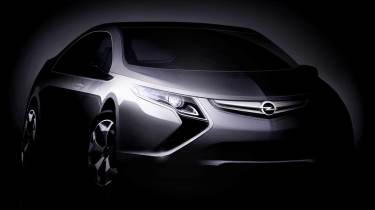Vauxhall Ampera
UK version of Chevrolet Volt 'hybrid'; Here in 2011, could be UK built
Meet the Opel Ampera, the European-market version of the much-vaunted Chevrolet Volt plug-in hybrid. It's due to go on sale in 2011, a year after the Volt itself, with a Vauxhall-badged, right-hand-drive sibling arriving shortly after the Opel. The main changes are to the nose design, but the interior will have European levels of finish too. All Amperas will initially be built in the US, but GM Europe is hoping to gain UK funding to build the cars at the Ellesmere Port factory. At the heart of the Ampera, which is built on a modified next-generation Astra platform (a car itself due for launch this year), is a 1.4-litre petrol engine, a 111bhp electric motor, a generator and a T-shaped battery which sits under the rear seat and along the centre tunnel. The whole system is dubbed Voltec, and as of now we must stop calling it a plug-in hybrid because, says Gherado Corsini who is GM's director of the E-REV project, the Ampera is not a hybrid. This is a because a hybrid, by GM's definition, uses direct internal combustion engine power at least some of the time, whereas an E-REV, or extended-range electric vehicle, is always propelled by electricity alone. The battery is usually charged overnight, which gives enough range for an average commute, but the range can be extended by firing up the engine which drives a charging generator. Hans Demant, Opel's MD and its biggest engineering brain, insists that the Ampera will be fun to drive. A petrol engine can be made very efficient by running it at a constant speed, but the unchanging drone can get annoying. So Demant has sacrificed a 'very small' amount of efficiency to allow the engine speed (when the engine is in use) to be modulated according to car speed and accelerator pedal position, so the aural sensation will be more like that of a normal car. The five-door hatchback's lithium-ion battery pack is never allowed to run right down, but you might expect performance to tail off as charge drops low. After all, if the petrol engine makes less than 111bhp, how can the Ampera maintain its potential pace? Because we have to rethink our notions of how cars work. All the engine does is recharge the battery, and the rate it does this can be altered to ensure 111 electric bhp remains on tap at the front wheels. 'It's not bad at all,' says Demant. 'Actually it feels pretty good.' GM won't be drawn on pricing yet, but with an expensive battery pack (its components made by Korean company LG) about four or five times the size of those found in today's hybrids, the Ampera won't be cheap to buy. The battery pack, however, is designed to last the life of the car, which will mean at least 10 years, and GM is likely to devise some form of Ampera leasing deal.



